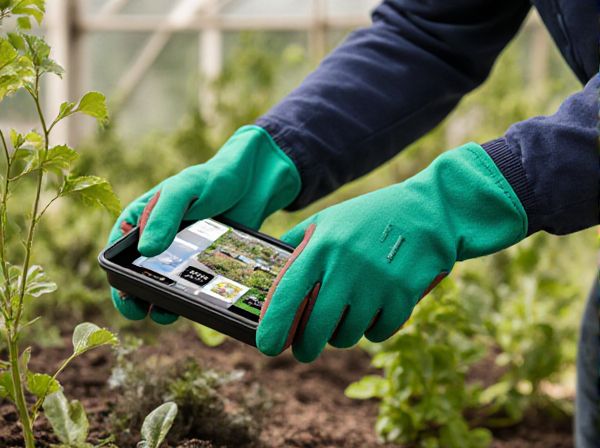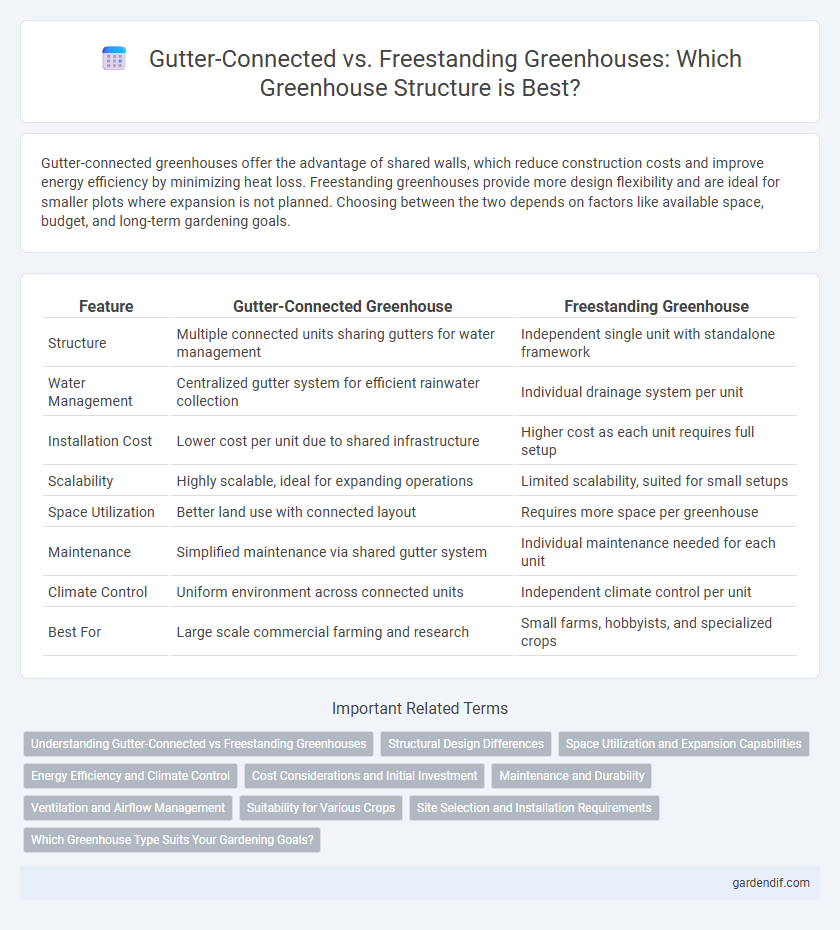
Gutter-Connected Greenhouse vs Freestanding Greenhouse Illustration
Gutter-connected greenhouses offer the advantage of shared walls, which reduce construction costs and improve energy efficiency by minimizing heat loss. Freestanding greenhouses provide more design flexibility and are ideal for smaller plots where expansion is not planned. Choosing between the two depends on factors like available space, budget, and long-term gardening goals.
Table of Comparison
| Feature | Gutter-Connected Greenhouse | Freestanding Greenhouse |
|---|---|---|
| Structure | Multiple connected units sharing gutters for water management | Independent single unit with standalone framework |
| Water Management | Centralized gutter system for efficient rainwater collection | Individual drainage system per unit |
| Installation Cost | Lower cost per unit due to shared infrastructure | Higher cost as each unit requires full setup |
| Scalability | Highly scalable, ideal for expanding operations | Limited scalability, suited for small setups |
| Space Utilization | Better land use with connected layout | Requires more space per greenhouse |
| Maintenance | Simplified maintenance via shared gutter system | Individual maintenance needed for each unit |
| Climate Control | Uniform environment across connected units | Independent climate control per unit |
| Best For | Large scale commercial farming and research | Small farms, hobbyists, and specialized crops |
Understanding Gutter-Connected vs Freestanding Greenhouses
Gutter-connected greenhouses share common walls and gutters, allowing for efficient space utilization and cost savings in large-scale commercial operations. Freestanding greenhouses are standalone structures offering greater design flexibility and better climate control due to isolated environments. Choosing between them depends on factors like available land, budget constraints, and intended crop types.
Structural Design Differences
Gutter-connected greenhouses feature multiple bays joined by shared gutters that facilitate efficient water drainage and optimize space utilization, making them suitable for commercial-scale production. Freestanding greenhouses are standalone structures with independent frames and separate drainage systems, offering greater flexibility in location and design customization. The structural design of gutter-connected greenhouses emphasizes uniform load distribution across interconnected bays, while freestanding greenhouses rely on isolated framework stability to withstand environmental stresses.
Space Utilization and Expansion Capabilities
Gutter-connected greenhouses maximize space utilization by linking multiple units side-by-side, creating a larger continuous growing area with shared walls that reduce material costs and heat loss. Freestanding greenhouses offer greater flexibility in placement and design, making them ideal for sites with irregular shapes or where modular expansion is less predictable. Expansion in gutter-connected systems involves adding connected bays, while freestanding greenhouses allow independent additions without structural dependency.
Energy Efficiency and Climate Control
Gutter-connected greenhouses share walls, reducing heat loss and improving energy efficiency by minimizing exposed surfaces, while freestanding greenhouses require more energy for heating due to their isolated structure. Climate control in gutter-connected greenhouses benefits from shared thermal mass and reduced air infiltration, allowing more stable temperature regulation. Freestanding greenhouses offer greater design flexibility but demand more advanced HVAC systems to maintain optimal growing conditions and energy efficiency.
Cost Considerations and Initial Investment
Gutter-connected greenhouses typically require a higher initial investment due to the need for shared structures and integrated systems, resulting in cost savings over time through reduced materials and energy efficiency. Freestanding greenhouses have lower upfront construction costs, offering flexibility in location and design but often incur higher long-term expenses for heating and cooling. Evaluating the total cost of ownership, including installation, maintenance, and energy use, is essential for optimal budget allocation in greenhouse projects.
Maintenance and Durability
Gutter-connected greenhouses offer enhanced durability through shared structural support, reducing the risk of damage from strong winds and weather conditions compared to freestanding greenhouses. Maintenance is generally easier in gutter-connected systems since gutters streamline water drainage, preventing water buildup and potential damage to the foundation. Freestanding greenhouses require more frequent upkeep due to their isolated exposure to elements and typically face higher risks of structural wear over time.
Ventilation and Airflow Management
Gutter-connected greenhouses benefit from shared ventilation systems that allow for improved airflow management across multiple units, enhancing temperature control and humidity regulation. In contrast, freestanding greenhouses rely on independent ventilation setups, which may limit airflow efficiency but offer greater flexibility in environmental adjustments tailored to specific crops. Optimizing vent placement and incorporating automated vent openers are critical in both designs to maintain consistent airflow and prevent heat buildup.
Suitability for Various Crops
Gutter-connected greenhouses excel in supporting high-density crop production such as tomatoes, cucumbers, and peppers due to their modular design that allows easy expansion and efficient climate control. Freestanding greenhouses offer greater flexibility for diverse crops including leafy greens, flowers, and specialty herbs, benefiting from unobstructed internal space and independent operation. Crop selection is influenced by the greenhouse structure, where gutter-connected systems optimize uniform environmental conditions, while freestanding models accommodate variable spacing and crop-specific light requirements.
Site Selection and Installation Requirements
Gutter-connected greenhouses require a larger, contiguous site with minimal slope to accommodate multiple connected bays sharing gutter lines, optimizing space but demanding precise site grading and drainage management. Freestanding greenhouses offer more flexibility in site selection, adapting to uneven terrain or confined spaces without relying on adjacent structures, though each unit requires independent foundation and utilities installation. Installation of gutter-connected systems involves coordinated assembly and integrated roofing, while freestanding greenhouses can be installed individually, facilitating phased expansion but potentially increasing total setup time and cost.
Which Greenhouse Type Suits Your Gardening Goals?
Gutter-connected greenhouses attach to an existing structure, offering better temperature control and increased energy efficiency by sharing walls, ideal for gardeners with limited space or seeking cost-effective expansion. Freestanding greenhouses provide greater design flexibility, maximizing sunlight exposure and allowing for larger, standalone setups suited for commercial growing or diverse plant collections. Choosing between these depends on your available space, budget, and specific gardening goals regarding plant variety and environmental control.
Gutter-Connected Greenhouse vs Freestanding Greenhouse Infographic

 gardendif.com
gardendif.com